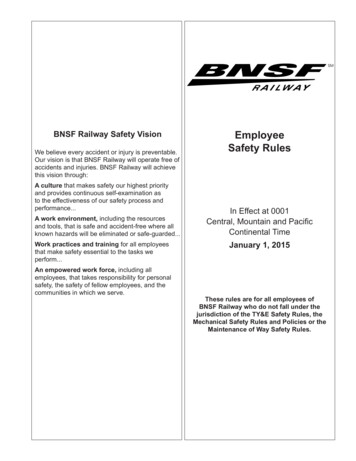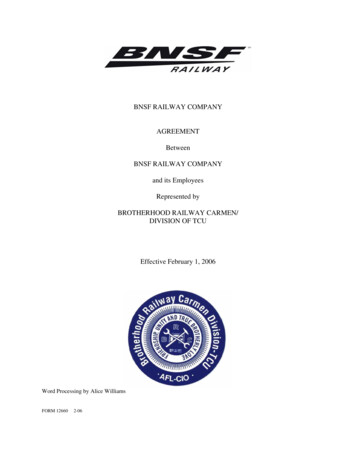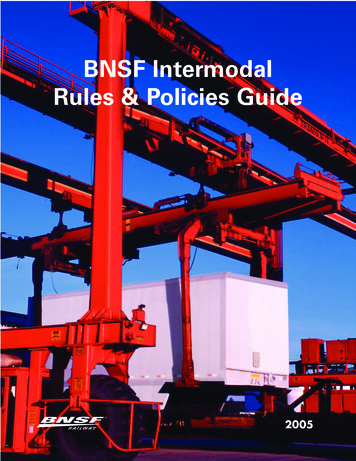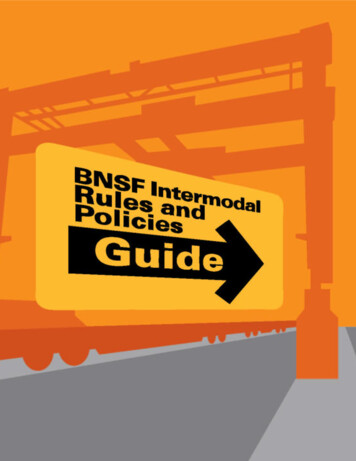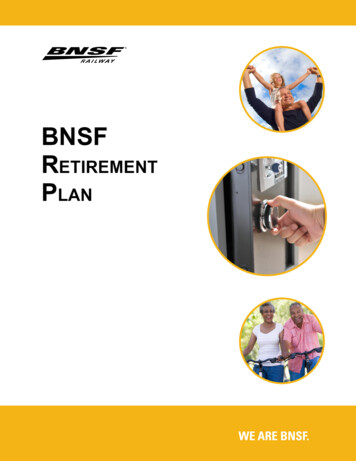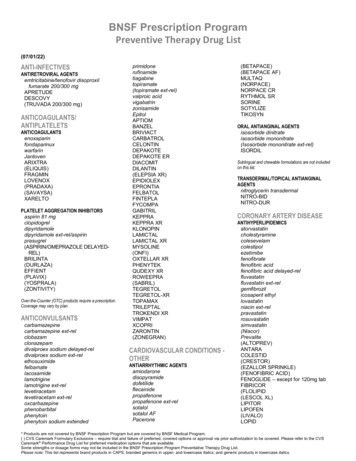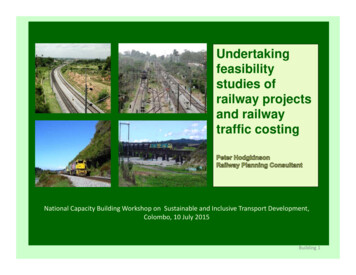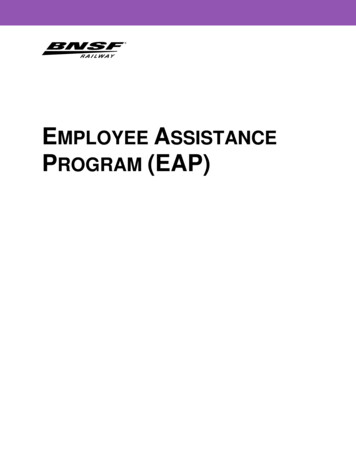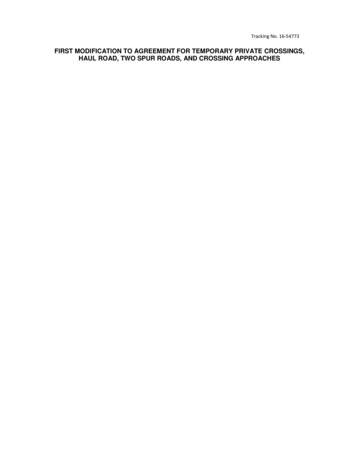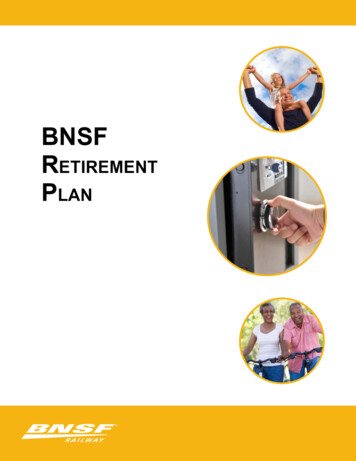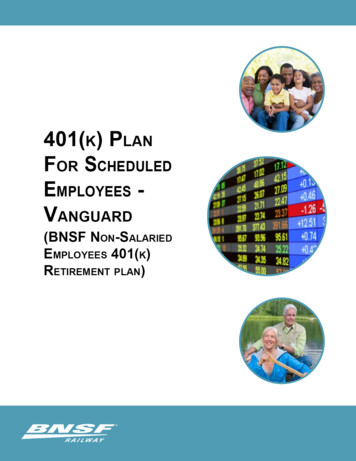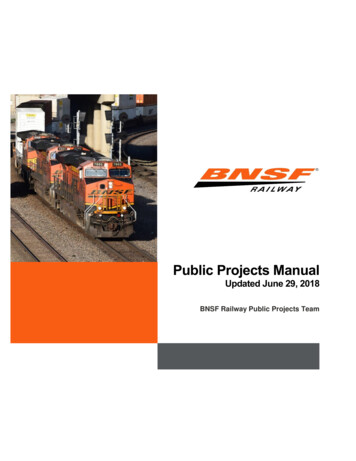
Transcription
Public Projects ManualUpdated June 29, 2018BNSF Railway Public Projects Team.
BNSF Railway Public Projects ManualNote: The information contained in this BNSF Railway Public Projects Manual is neitherexhaustive nor exclusive; rather, it is intended to be a general resource only and allstatements contained herein are intended to be for broad use. Nothing identified in this BNSFRailway Public Projects Manual can be taken as authority to construct or improve. Specificprojects will be subject to analysis of all factors leading to formal agreements between all projectparties. The purpose of BNSF review is solely to confirm compliance with the minimum standardsof BNSF, and not for any other purpose.i
BNSF Railway Public Projects ManualTable of Contents1.0Introduction to this Manual. 12.0BNSF Public Projects and JLL General Roles, Contacts, and Territories. 22.1BNSF Public Projects Team . 32.2JLL Team . 32.3Flowchart of the Roles of BNSF and JLL Teams . 43.0Additional BNSF Resources and Contacts . 54.0Definition of Terms . 65.0Summary of Steps for Outside Party Projects .105.1Typical Steps for Design Review.105.2Typical Steps for Construction Submittal Review .1115.3State DOT/PUC Requirements .1225.4BNSF Fourth Quarter Construction Moratorium .1226.0Project Alternative Delivery.137.0Payment of BNSF’s Cost and Expense .137.1Key Points .137.2General Billing and Reimbursement Requirements .137.3Work to be Completed by BNSF (Force Account Work) .147.4Work to be Completed by the Proponent .148.0Requirements for BNSF Engineering Review .148.1Key Points .148.2Overview .158.3Process Steps to Be Taken.158.4Cost and Expenses .158.5Timing .158.6Standard Documents .169.09.110.0Summary of Submittal Review Schedules .16General Review Schedule by Project Type .16Insurance Requirements for Public Projects .1810.1Overview .1810.2Insurance Requirements .1811.0Entry onto BNSF Property .19iii
BNSF Railway Public Projects Manual11.1Key Points .1911.2Overview .1911.3Entry for Construction Work via BNSF Public Projects .2011.4Entry for Non-Construction Work via JLL .2111.5Entry for Other Purposes via JLL .2111.6Other Contractor Requirements .2311.7Railroad Flagging for Activities On or Near BNSF Property and Tracks .2611.8Examples of On-Track Safety Protection .2711.9Which Method of On-Track Safety is Appropriate?.2811.10 Spill Reporting .2812.0Construction Monitoring Requirements .2812.1Overview .2812.2General Guidelines .2912.3Inspector/Coordinator (I/C) Consultant .2913.0Signal and Communications Cable Locates and Protection .3113.1Key Points .3113.2Overview .3113.3General Guidelines .3113.4General Process .3214.0Underground Utility Crossings .3215.0Highway-Rail Grade Crossing Surface Maintenance and Replacement.3315.1Key Points .3315.2Overview .3315.3Crossing Design and Construction .3415.4Crossing Maintenance and Replacement.3415.5Maintenance Blitz .3415.6Modifications to Crossings .3415.7Contacts .3515.8Additional Information on Crossings .3516.0Alterations to Highway-Rail Grade Crossing Warning Devices .3516.1Key Points .3516.2Overview .3616.3Definitions .36iv
BNSF Railway Public Projects Manual16.4Identification of the Crossing and Location .3916.5Design Considerations .3916.6Engineering, Cost Estimation, and Installation .4016.7Operation of Highway-Rail Grade Crossing Warning Devices .4016.8Traffic Signal Preemption Interconnection .4117.0Public and Private Road Crossing Openings and Closures and Grade Separation .4217.1Key Points .4217.2Overview .4217.3New Crossings – Public .4217.4New Crossings – Private .4317.5Closure Procedure – Public .4317.6Closure Procedure – Private .4417.7Division of Work for New Crossings .4417.8Additional Information on Crossings .4517.9Ownership and Maintenance for Grade Separations .4518.0Train Horn Mitigation Proposals (Quiet Zones or Wayside Horns) .4618.1Key Points .4618.2Overview .4718.3Policy on Quiet Zones .4718.4Preliminary Planning for Quiet Zones .4718.5Getting Started: Process for Pursuing a Quiet Zone.4718.6Wayside Horn Systems .4919.019.1Bicycle/Pedestrian Pathways and Multi-Use Trails .50Overview .5019.2 BNSF Policy on Bicycle/Pedestrian Pathways and Multi-Use Trails Crossing BNSFProperty.5019.3 BNSF Policy on Bicycle/Pedestrian Pathways and Multi-Use Trails Parallel to BNSFProperty.5120.0Overpass and Underpass Structure Projects .5120.1Key Points .5120.2Overview .5220.3General Guidelines .5220.4Temporary and Permanent Construction Clearances .5321.0Retaining Wall Projects .55v
BNSF Railway Public Projects Manual21.1Overview .5521.2Walls Supporting Railroad Embankment .5521.3Walls Not Supporting Railroad Embankment .5522.0Parallel Roadway Construction Projects .5622.1Key Points .5622.2Overview .5622.3General Guidelines .5722.4Other Considerations .5723.0 Cleaning and Painting BNSF Bridges and Structures and Other Bridges over BNSFProperty .5723.1Cleaning and Painting of Railroad Bridges – Key Points .5723.2Cleaning and Painting of Railroad Bridges – Overview .5823.3Consideration of Railroad Bridge Cleaning and Painting Projects .5823.4Submission of Railroad Bridge Cleaning and Painting Project Requests.5823.5Cleaning and Painting of Other Bridges over BNSF – Key Points .5923.6Cleaning and Painting of Other Bridges over BNSF –Overview .5924.0Use of Cranes, Lifting of Material, and Demolition on or Over BNSF Right-of-Way .6024.1Key Points .6024.2Overview .6024.3Erection .6024.4Falsework .6124.5Demolition .6124.6Vibratory Pile Driving .6225.0Leases, Easements, and Property Purchases .6325.1Key Points .6325.2Overview .6325.3Process.6325.4General Guidelines .6426.0Track Abandonment .6426.1Key Points .6426.2Overview .6426.3Disposition and Acquisition of Surplus and Used Track Material .65vi
BNSF Railway Public Projects ManualFiguresFigure 1: Flowchart of the Roles of BNSF and JLL Teams . 4Figure 2: BNSF Public Projects Design Plan Submittal Flow Chart .11Figure 3: BNSF Public Projects Construction Plan Submittal Flow Chart .122Figure 4: Example Passive Warning System at Grade Crossing .37Figure 5: Example Active Warning System at Grade Crossing .38TablesTable 1: BNSF Safety and Security Contact Information . 5Table 2: BNSF Passenger Operations Contacts . 5Appendices Appendix AoGrade Crossing AgreementoOverpass AgreementoUnderpass Agreement Appendix BoBNSF Contractor Requirements (Exhibit C)oBNSF Contractor Right-of-Entry Agreement (Exhibit C-1) Appendix CoBNSF Utility Accommodation Policy Appendix DoDemolition GuidelinesoShoring GuidelinesoUPRR – BNSF Joint Guidelines for Railroad Grade Separation Projects Appendix EoBNSF Review Comment Sheet Examplevii
BNSF Railway Public Projects ManualAdditional information can be acquired through the following sources: American Railway Engineering and Maintenance of Way Association (AREMA), AREMAManual for Railway Engineering, http://www.arema.org U.S. Department of Transportation (USDOT) / Federal Highway Administration (FHWA),Manual on Uniform Traffic Control Devices, http://mutcd.fhwa.dot.gov/ Union Pacific Railroad (UP) and BNSF Railway (BNSF), Union Pacific Railroad – BNSFRailway Guidelines for Railroad Grade Separation Projects manual ts/document/pdf rr grade sep projects.pdf USDOT Railroad-Highway Grade Crossing m roaduser/07010/index.cfm Federal Railroad Administration Office of Safety Analysis (for USDOT Inventory NumberLookup): lt.aspx Federal Railroad Administration Safety Map (for USDOT Inventory Number Lookup):http://fragis.fra.dot.gov/GISFRASafety/ Federal Railroad Administration Final Rule and Information on Quiet Zones:https://www.fra.dot.gov/Page/P0889viii
BNSF Railway Public Projects Manual1.0 Introduction to this ManualThe information contained in this BNSF Railway Public Projects Manual is intended to assistcommunities, public agencies, and other Proponents to coordinate, plan, and implementconstruction and improvement projects that may potentially involve BNSF Railway (BNSF)property. Some examples of such projects generally include: Highway-Rail Grade Crossings: Closure, removal, installations, alterations, and GradeSeparation of public highway-rail grade crossings.Entry onto BNSF Property: Temporary rights of entry onto BNSF property, easements,utility installations, and other temporary access needs such as highway overhead bridgeinspections.Bridges Carrying BNSF: Construction, reconstruction, rehabilitation, repair, removal,and maintenance of bridges carrying railway lines of BNSF over roadways and otherpublic properties initiated by outside parties.Bridges Over BNSF: Construction, reconstruction, rehabilitation, repair, removal, andmaintenance of bridges over BNSF railway lines by outside parties.Parallel Roads and Facilities: Construction, reconstruction, modification, removal, andmaintenance of parallel roads or other public facilities (including multi-use trails)potentially affecting BNSF property and/or operations.Beautification and Bridge Painting: Modification of structures over or adjacent toBNSF involving aesthetic work; or painting of structures over or adjacent to BNSFproperty.Quiet Zones: Information for a Proponent proposal to potentially establish a new QuietZone that encompasses the BNSF network.Other Projects Involving BNSF Corridors: Publicly sponsored projects involving oraltering BNSF facilities or its property. These projects may be on, above, adjacent to, orotherwise have the potential to impact BNSF property and operations.Users of this BNSF Railway Public Projects Manual should consider that prior toinitiating contact with the BNSF Public Projects team regarding a proposed PublicProject, communities, public agencies, and other Proponents should first ascertainwhether or not the project potentially involves BNSF-owned property.The resources and strategies identified below can be used by the public to support this processand to reduce possible confusion about a specific project location potentially involving BNSFowned property. Consult the current BNSF Network Map and other mapping resources on the BNSFwebsite that identify BNSF-owned line segments, and all states and provinces and manycities served by BNSF. The BNSF website can be accessed shipping-locations/rail-networkmaps.html Consult the Federal Railroad Administration (FRA) Office of Safety Analysis HighwayRail Crossing Database to make a query of a grade crossing by location for state,county/city, and street name. There is often more than one crossing on the sameroadway, but the Grade Crossing Inventory Report generated by searching the databaselists the precise latitude and longitude of the grade crossing for cross-reference. Also,1
BNSF Railway Public Projects Manualeach grade crossing has a unique DOT inventory identification number that typicallyincludes six digits and one letter – such as 123456A – which is indicated on the report aswell as on the signal bungalow at the crossing if applicable. To avoid confusion,reference the DOT Crossing Number in any correspondence with the BNSF PublicProjects team regarding the crossing. The FRA Grade Crossing Inventory Databasewebsite can be accessed /publicsite/crossing/Xingqryloc.aspx To ascertain if a specific parcel of land is BNSF property, interested parties cangenerally check with a local tax assessor or consult local courthouse records. Note that BNSF trains, locomotives, railcars, and equipment can operate on a rail lineowned by BNSF or over rail lines owned by other railroads, and that these observationsof railway operations should therefore not be used by the public to ascertain whether ornot a specific rail line is potentially owned by BNSF.Users of this BNSF Railway Public Projects Manual should also consider the following: The safety of BNSF employees and the public is of paramount importance toBNSF. The specific BNSF requirements for projects, as described in this BNSF Railway PublicProjects Manual, shall be followed at all locations where BNSF owns and/or operates,regardless of track ownership or whether or not the track is either active or out-ofservice. The guidelines and requirements contained in this BNSF Railway Public Projects Manualare provided for reference only and are subject to revision without notice. All newprojects and shall be designed in accordance with the most current BNSF policies,requirements, and standards. Any items or project types affecting BNSF property that are not covered in this BNSFRailway Public Projects Manual are also subject to BNSF’s prior review and approval.2.0 BNSF Public Projects and OutsideProperty Manager General Roles, Contacts,and TerritoriesBNSF Railway Company (BNSF) is headquartered in Fort Worth, Texas, and operates one ofthe nation’s largest Class I rail networks, with approximately 32,500 route miles in 28 statesacross the western two-thirds of the United States, and in two Canadian provinces. BNSF'sPublic Projects team is involved in a broad array of projects initiated by government agenciesand other parties, as well as BNSF itself, in the communities across the railway’s network.A primary role of the BNSF Public Projects team is to work with and assist government agenciesor other Proponents, including processing contracts, when they have made a determination tomake modifications to at-grade crossing or grade-separated crossing (public or private). Thisincludes modifications to the crossing surface, railroad Active Warning Devices (includingflashing light signals and gates), traffic signals interconnected to railroad signals, bridge2
BNSF Railway Public Projects Manualmaintenance, roadway lane widening or addition of new sidewalks across the railroad, and newgrade separations. The BNSF Public Projects team is also involved in grade crossing closures,multi-use trails, any improvement project paralleling BNSF property, and any effort by agovernment agency to seek establishment of a Quiet Zone that encompasses the BNSFnetwork. Identification of any permits, agreements, and other documentation required by BNSFfor the facilitation of public projects work is included by project type throughout this BNSFRailway Public Projects Manual. A flow chart showing the roles of the BNSF Public Projectsteam and contact information for the BNSF Public Projects team by territory is presentedthroughout this section (click here to reference Figure 1 to access the flow chart).To help facilitate the needs of government agencies and other Proponents regarding the PublicProjects process, BNSF has partnered with Jones Lang LaSalle Brokerage, Inc. (JLL) toprocess permits, licenses, leases, and easements on BNSF property. JLL also handles thefollowing additional roles for projects on BNSF property: Private Crossing permits, TemporaryOccupancy Permits, installation of new utilities; storing of material or equipment; performingminor construction work such as soil borings or grading; surveying; and geotechnicalengineering. JLL also facilitates sales of BNSF real estate and any general propertymanagement for BNSF.Additional details about the services JLL provides can be found on the BNSF website mits. Identification of any permits, licenses,agreements, and other documentation required by BNSF for the facilitation of public projectswork is included by project type throughout this BNSF Railway Public Projects Manual. A flowchart showing the roles of the JLL team and contact information for the JLL team by functionand territory is presented throughout this section (click here to reference Figure 1 to access theflow chart).2.1 BNSF Public Projects TeamA BNSF Public Projects Management Staff and Territory Map with related contact informationcan be found at: ts/index.html2.2 JLL TeamA JLL Permit Management Team Territory Map as well as the Lease Management TeamTerritory Map with related contact information can be found at: html3
BNSF Railway Public Projects Manual2.3 Flowchart of the Roles of BNSF and JLL TeamsA flowchart showing the roles of BNSF and JLL teams is shown in Figure 1 below.Figure 1: Flowchart of the Roles of BNSF and JLL Teams4
BNSF Railway Public Projects Manual3.0 Additional BNSF Resources and ContactsMany areas of community interest are outside of the purview of the BNSF Public Projects andJLL teams and the scope of this BNSF Railway Public Projects Manual. Identified below is a listof additional BNSF resources and contacts that may be helpful on other community matters andpublic inquiries.Emergencies: BNSF Resource Protection Command Center (1-800-832-5452).Table 1: BNSF Safety and Security Contact InformationNameContactEmergenciesReport Trespassers or Criminal ActivityMake an Anonymous Report1-800-832-5452 (Option 1)1-800-832-5452 (Option 3)1-800-832-5452 (Option 4)BNSF Community Affairs: This BNSF team includes Public Affairs Directors who addressBNSF challenges and opportunities at the local, county, and regional government levels, andserve as liaisons with the public and the media. All media inquiries must be directed to theBNSF Public Affairs team, whose contact information is available at the following .htmlBNSF Tribal Relations: The BNSF Tribal Relations team builds and strengthens relationshipswith the 86 tribal and first nation communities across the BNSF network. The BNSF TribalRelations team also provides internal training and technical guidance on protecting culturalresources, interaction with tribal representatives, and other topics involving BNSF’s interactionwith tribal communities. Their contact information is available at the following elations/BNSF Government Affairs: BNSF state and federal government affairs teams work to educateand inform public policymakers at local, state, and federal levels. These teams primarily focuson legislative and regulatory matters as well as working with communities to seek solutions ofmutual interest. Their contact information is available at the following F Passenger Operations: Commuter (or suburban) passenger trains operate over varioussegments of the BNSF network, and include Metra (Chicago Area); Metro Transit (Minneapolis,Area); and Sound Transit (Seattle, Area).Table 2: BNSF Passenger Operations ContactsNameMetra Suburban Service (Chicago Area)Metro Transit (Minneapolis Area)Sound Transit (Seattle Area)Contact312-322-6777612-373-3333 (Option 3)206-398-50005
BNSF Railway Public Projects ManualOther BNSF Teams: BNSF has additional teams that may have interaction with communities,public agencies, and other Proponents. Fo
BNSF Railway Public Projects Manual 1 1.0 Introduction to this Manual The information contained in this BNSF Railway Public Projects Manual is intended to assist communities, public agencies, and other Proponents to coordinate, plan, and implement construction and improvement projects that may potentially involve BNSF Railway (BNSF) property.
